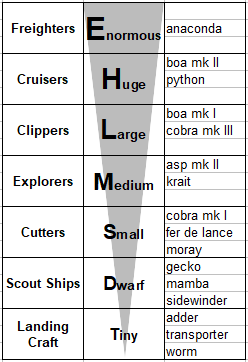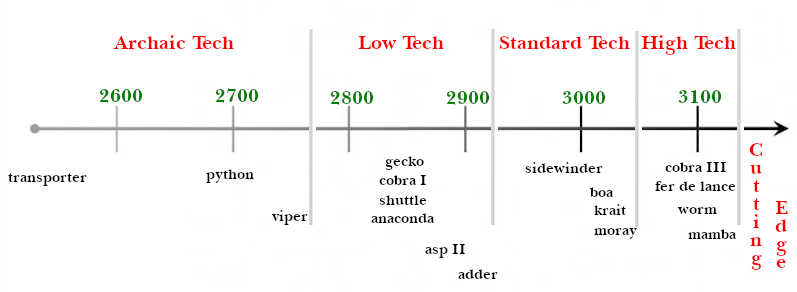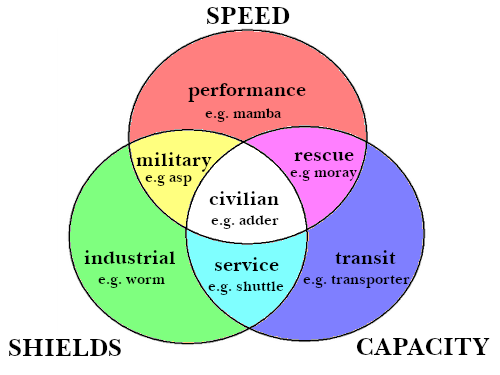At long last, I've come to looking at this oxp again.
Although very fond of it, it was more the case of being happy with the idea than with the implementation. Version 1.90 of oolite has allowed the possibility of equipment override plists thereby removing some of the obstructions I was working under (major one being my lack of experience with javascript...) So after some thought and initial tests I'm confident I can do it much more justice.
So an excuse for a rethink and a clearer, less cluttered roadmap.
Ship Size
So scale is a mess in oolite as I suspect most of us are aware (at least when it comes to trying to make sense of it) but in sci fi and amongst vehicles generally I think it's a pretty common and important discriminator. So using the default shipset, here's the plan.
 EDIT:
EDIT: Or, after noticing the Ship Mass table here
![[EliteWiki]](/images/elitewikismall.png) Escort Deck
Escort Deck --->

Larger ships will have less proprtional thrust (more mass to move) and therefore take longer to reach top speed but then they'll also gain more cargo space from the cargo bay extension. Fuel will also be more costly with increasing size. More adjustments are planned but have yet to be implemented.
Ship Tech
Using the inservice dates from the original Elite manual, there's a fairly nice spread and implied progression. Both the categories themselves and their placement are my additions but they present a pleasing consistency, to my mind at least.
 EDIT:
EDIT: Altered to display an increasing rate of advancement as well as to leave some room for the likes of constrictors, interceptors and even the formidable boa mk II...
Increasing tech level will grant superior injector burn rate, sun glare reduction and equipment options but at the cost of more expensive maintenance. So higher tech is definitely desirable but also more expensive.
Ship Grade
The best and the worst thing about this oxp... the implementation of this has caused all kinds of trouble and compromise up until now.
The other two categories are supposed to be 'set in stone' for each ship but this one can be changed via purchasing a 'refit'. I wanted a more 'consistent' model and so looked again at how to approach this.

Remember, this category is the one that can be changed, so the ship examples given are ones either canonically operating within that area or actually doing so within the game. Their position within the venn diagram represnts the usefulness of each of the three properties (rather than each ship's inherant suitability) to that particular role. The civilian grade (being in the centre) has a mix of everything rather than the best of everything.
So we have the mamba developed from a racing ship, the navy asp, the moray med-ship, the worm miner etc. etc.
The categories (or 'grades') are mostly self-explanatory I think but perhaps 'industrial' and 'service' could do with an explanation.
Industrial in terms of what's already within the game would be the mining ships but could also be imagined as similarly industrial work within more hazardous areas - thus the usefulness of good shields.
Service would be represented in game by the station to planet traffic. So cargo has some importance here as similar to transit vessels their function is to supply. The chief difference between the two being that the transit vessels are likely to be traders and the service vessels more likely to be ferrying passengers or essential, operational supplies. So it's less important how many service vessels are used but more important that they actually arrive (losing a ferryload of public passengers makes for terrible press). For that reason, shields are more important than they would be to a trader although this grade of ship is actually the slowest of them all (represented as being directly opposite the performance zone of the speed circle).
Speed will grant higher injector speeds.
Shields will grant a shield bonus (or malus).
Capacity will grant more cargo space (the transit grade fitting requiring the least ammount of space).
There are further planned (but not yet tested) to be a set of dynamic tensions to encourage choice rather than just enforce exclusivity.
These planned tensions are:
- between cargo space used and top speed (adjusted for size)
- between cargo space and equipment installed (standardised for all ships)
- between equipment installed and top speed (adjusted by tech)
So (crudely) less stuff = more speed.
Potentially a nice bonus for the beginner who can't afford to fill up a hold with the good stuff and food for though for those who can. Rather than just dropping the cargo capacity and increasing the speed it's about strategy and choice.
Not to everyone's taste I'm sure but the art is in the balancing. So if a player-python with only a half full cargo bay runs faster than the standard 0.2LM then I think many would find it more fun to play. For example you could take that 100TC contract but could you also afford the speed hit while going through those dangerous systems en route?







